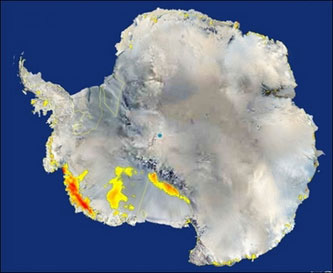California-sized area of snow melt spotted in Antarctica
California-sized area of snow melt spotted in Antarctica
mongabay.com
May 16, 2007
NASA has found clear evidence of a California-sized area of snow melting in west Antarctica in January 2005 in response to warm temperatures.
Using data from NASA’s QuikScat satellite, scientists found melting in multiple regions, including “far inland, at high latitudes and at high elevations, where melt had been considered unlikely.” They saw observed melting snow at up to 900 kilometers (560 miles) inland from the open ocean, farther than 85 degrees south (about 500 kilometers, or 310 miles, from the South Pole) and higher than 2,000 meters (6,600 feet) above sea level. The scientists say that maximum air temperatures at the time of melting were “unusually high, reaching more than five degrees Celsius (41 degrees Fahrenheit) in one of the affected areas.”

NASA’s QuikScat satellite detected extensive areas of snowmelt, shown in yellow and red, in west Antarctica in January 2005. Image credit: NASA/JPL |
“Antarctica has shown little to no warming in the recent past with the exception of the Antarctic Peninsula, but now large regions are showing the first signs of the impacts of warming as interpreted by this satellite analysis,” said Konrad Steffen, director of the Cooperative Institute for Research in Environmental Sciences at the University of Colorado, Boulder, who led the research team. “Increases in snowmelt, such as this in 2005, definitely could have an impact on larger-scale melting of Antarctica’s ice sheets if they were severe or sustained over time.”
The scientists said the 2005 melt created an extensive ice layer when water refroze following the melt, but that the water did not last long enough to flow into the ocean.
“Water from melted snow can penetrate into ice sheets through cracks and narrow, tubular glacial shafts called moulins,” Steffen explained. “If sufficient melt water is available, it may reach the bottom of the ice sheet. This water can lubricate the underside of the ice sheet at the bedrock, causing the ice mass to move toward the ocean faster, increasing sea level.”
The study, “Snow Accumulation and Snowmelt Monitoring in Greenland and Antarctica,” appears in the recently published book “Dynamic Planet.”
This article is based on a news release from NASA














